Mark Sisson's Blog, page 56
December 8, 2020
Setting Healthy Boundaries around the Holidays
 When you were a kid, adults probably drilled into you that you should “be nice,” share your toys, and put yourself in other people’s shoes. Those are necessary lessons, of course. Humans are prosocial creatures. Our ancestors needed the protection of the clan, so they had to get along and be team players. Individuals who caused strife within the group risked being kicked out, which could be a death sentence.
When you were a kid, adults probably drilled into you that you should “be nice,” share your toys, and put yourself in other people’s shoes. Those are necessary lessons, of course. Humans are prosocial creatures. Our ancestors needed the protection of the clan, so they had to get along and be team players. Individuals who caused strife within the group risked being kicked out, which could be a death sentence.
It pays to be considerate of others, but that message often gets twisted into “don’t rock the boat” and even “other people’s needs are more important than your own.” When getting along is your top priority, you become loathe to assert your own needs. However, in the long term, being too self-sacrificing is detrimental to your relationships and your own mental wellbeing. It’s a slippery slope into allowing other people to make unreasonable demands on your time or say or do things that hurt you (often unintentionally).
Moreover, not being honest about your needs is unfair. Other people never get the chance to reciprocate the consideration you’re offering, and all the while you are stewing in hurt or resentment because you aren’t getting what you want.
Boundaries protect your time and your physical and emotional space. They help ensure that your needs are met. Boundaries can look like:
Turning down social invitations.
Saying no to requests from your boss or coworkers that you can’t reasonably fulfill or that are outside your scope.
Staying true to your values (e.g., shutting down a conversation that has turned sexist or racist).
Protecting your personal space from other people who are sapping your time, energy, or happiness.
Enforcing much-needed personal time.
Did you get squeamish just reading that? The truth is, setting boundaries can incredibly uncomfortable, even downright scary. Keeping the peace is the path of least resistance, but it’s not always the right choice. Learning to set healthy boundaries is one of those necessary-but-difficult adulting skills that we all need to practice.
What Does It Mean to Set Healthy Boundaries?
Boundaries communicate how we want others to treat us.
The word makes it sound like they are walls we erect to keep other people at arm’s length, but the intention is actually to foster better relationships. Sometimes it does mean creating distance from someone. Often, though, you’re letting the other person know what they can reasonably expect from you or telling them what would make a given situation agreeable to you.
Boundaries are not “mean.”
Boundaries are honest. They facilitate positive interactions by reducing the likelihood of mixed signals, miscommunication, and disappointment. In fact, setting boundaries is an act of generosity for yourself and others. You could lie, shut down, or cut others out of your life when you’re not getting what you need. Instead, you’re doing the hard work to improve the situation.
As Brene Brown says, “Clear is kind. Unclear is unkind.” Boundaries create clarity. It’s kinder to give important people in your life—whether they be friends, romantic partners, relatives, your boss, even your hairdresser or personal trainer— the chance to have an authentic relationship with you. The alternative is letting them labor under the impression that you’re happy when you’re not. Think about how awful it feels to find out that a friend has been secretly upset with you, or your boss thinks you’ve been doing a lousy job, but you had no idea.
Brown uses the term “shared purpose” in the workplace context, but it is relevant to any of your relationships. When you prioritize “being nice” above being honest, people don’t ever really know where they stand with you. Relationships can only be successful and fulfilling when all parties are on the same page.
Boundaries are not selfish.
Other people’s needs are not more important than your own. Setting boundaries simply means putting your needs on par with others’.
This message can be hard to accept. Boundaries can feel selfish, especially if you aren’t used to asserting yourself. Others may act like you’re being selfish when your needs conflict with theirs. There’s nothing inherently selfish about candor. You can care about other people and be loving, helpful, and generous without exceeding your personal boundaries.
Sometimes you do use boundaries to create space to focus on yourself, and that’s not selfish either. Everyone deserves to prioritize their own wellbeing—all the time, but particularly when you’re dealing with illness (acute or chronic), grief, depression, or other issues. Who benefits if you collapse under the weight of trying to do it all?
Boundaries Don’t Mean You Never Compromise
You’re probably not going around setting boundaries in most of your day-to-day interactions. There’s no need. Boundaries are generally reserved for situations in which your time or physical or mental health need a buffer. Even then, nothing precludes you from seeking out mutually beneficial arrangements.
Even people who are great at boundaries don’t get their way all the time. They understand how to prioritize, but they’re willing to put their foot down when it matters.
Signs That You Aren’t Setting Healthy Boundaries
The following are signs that you’re in a situation where you probably need to establish better boundaries:
Resentment or simmering anger toward someone else
Consistently low energy/motivation to complete a task or interact with someone
Feeling disempowered, overwhelmed, or burned out
Saying “I have to…” or “I should…,” followed by dread, namely in situations where you don’t actually have to do that thing. You probably should pay your bills or call the dentist about your toothache. You don’t have to bake cupcakes for the bake sale or go to your parents’ house for Christmas.
How to Set Boundaries
1. Be honest with yourself.
Step one is asking yourself, “In what situations am I feeling overwhelmed or burned out? Toward whom do I feel resentful? Where do is my energy stretched too thin?”
Next, be totally candid with yourself, without judgment, about why you aren’t already setting better boundaries. You would have already done it if it felt easy. Something is making you avoid rather than confront the situation. Usually it’s that you don’t want the other person to be mad, hurt, or embarrassed, you strongly value being helpful or agreeable, or you fear social or professional repercussions.
2. Get clear on what you want.
In an ideal world, how would the situation be different? You can’t ask for what you want unless you know what that is.
For example, let’s say you have a coworker who repeatedly comes into your cubicle to chat, interrupting your workflow. Possible solutions (boundaries) include:
Request that they only email or text you during certain periods of the day.
Put a do not disturb sign on the back of your chair when you’re trying to focus, and ask them to respect that.
Schedule a standing morning coffee break with them, and ask them to let you work until then.
However, none of these is the right answer if what you really want is to keep your coworker relationships strictly professional, no idle chitchat necessary.
3. Ask for what you need.
Keep it clear and concise so the other person understands exactly what you’re requesting. Again, setting boundaries is not mean, so avoid apologizing or overexplaining. You can convey through your tone of voice and word choice that you feel neither angry nor aggressive.
Melissa Urban of Whole30 fame has a useful green-yellow-red system. Essentially, it means you employ the minimum effective dose needed to establish the boundary. Start by being gentle but direct if it’s your first time communicating the boundary and/or you suspect the other person is not intentionally overstepping. If you have to repeat yourself, or if the other person’s behavior is explicitly harmful, you should feel free to draw an even more explicit line in the sand.
Taking the coworker example, you might start by saying: “I love chatting with you, but I get my most focused work done in the morning. I need to be in the zone from 9 to 12. Will you jot down the things you want to remember to tell me, and we can catch up at lunch?”
If your coworker repeatedly “forgets” not to interrupt you:
“Remember, I said I need to concentrate in the mornings. Hold that thought until lunchtime.”
“I need my cubicle to be off-limits in the morning.”
“I can’t talk now.”
“Please don’t come into my cubicle just to chat.”
4. Hold firm
After you ask for what you want, there’s often an awkward pause, or sometimes the other person apologizes profusely. You might be tempted to add a concession that suggests maybe the boundary isn’t firm. That’s not clear, which means it’s not kind.
Do: “I have a hard time refocusing when I’m interrupted. When I’m wearing my headphones, that’s my sign I’m not available to chat. Let’s catch up at lunch.”
Don’t: “I have a hard time refocusing when I’m interrupted. When I’m wearing my headphones, that’s my sign I’m not available to chat. I mean, unless it’s really important. Don’t even worry about it.”
What If the Other Person Gets Upset?
They might, and that’s not your problem. You can only control how you communicate, not how the other person reacts.
Don’t expect them to react badly, though. Other people often respond with grace if you communicate your needs in a straightforward, non-blaming manner. Sometimes they will react with hurt, anger, or defensiveness. Your job here is to hold firm and stay in your truth. Don’t apologize or backpedal. “I understand it’s disappointing, but the answer is no. Maybe we could pick up this conversation again in a day or two.”
In healthy relationships, setting boundaries usually works. The recipient might initially respond poorly, and they may sometimes overstep by mistake. Just as setting healthy boundaries feels uncomfortable, being on the receiving end can be difficult too. Most people don’t have a lot of practice in either role. However, good relationship partners ultimately respect your boundaries.
When you keep having to set the same boundaries with someone over and over, or if they respond with extreme negativity, you need to ask yourself whether they are someone you want in your life. An inability to respect boundaries is a sign of a toxic relationship.
Setting Boundaries This Holiday Season
The holiday season can seriously test your boundary-setting skills. Between the increased demands on your time and extended family dynamics, a whole fortress could be in order! Here are some examples, from gentlest to firmest:
When You Want Certain Discussion Topics to Be Off the Table:
Example:
We’d love to see you, but we’re all feeling extremely burned out after this election cycle. We’ll only be able to attend if we can agree not to talk politics at the dinner table. If everyone is amenable to that, let me know, and I’ll start making travel arrangements.
We’ll come, but we aren’t staying if there’s a repeat of last year. We’re going to have to leave if anyone starts fighting about politics.
Honestly, I’m feeling skittish about how much animosity there has been lately. I’m going to pass on the holidays this year.
Example:
I know you’re concerned about my health, but it makes me uncomfortable when you bring up my weight. I’m taking care of myself, and I don’t want to discuss my body. Can we please change the subject?
I only discuss this topic with my doctor. I need you to respect that and not ask me about my weight anymore.
My body isn’t anyone else’s business, and comments about my weight are hurtful. Please stop.
Example:
No thanks, I’m not drinking right now. I don’t mind if other people are drinking, but I’m doing a personal experiment. I hope nobody tries to pressure me.
I’m not drinking right now, and I’d like everyone to respect that. Thanks.
Nobody else is affected if I don’t drink. Let’s please drop it and have a pleasant evening.
Safety, Personal Comfort Regarding COVID Measures
Example:
Thank you so much for the invitation, but with everything being so crazy right now, we’re going to stay home. Let’s plan to Zoom, though! When is best for you?
We’re disappointed too, but we have to do what makes us feel safe. This year, it’s staying home. We’ll miss everyone.
We’re not comfortable compromising on this. The answer is no, and we’re not going to change our minds.
Example:
Thanks for inviting us! We will come grab a cocktail in the backyard, but when people start to move inside, we’re going to head home.
We’d only feel safe coming if it was a small group and everyone is outdoors. If not, we’ll pass this time, but we look forward to seeing you a different time!
We’re not comfortable socializing in groups right now. Thanks for asking, though.
(Remember, “Thank you so much for inviting us, but we’re unable to attend” is a complete response. These suggestions are for when you want to offer more explanation or if the host is pressing you for more.)
Setting Aside “Me” Time, Protecting Your Schedule
Example:
Hey, [spouse/partner]. With holiday busyness, I’m having a hard time finding any time to exercise. It’s really affecting how I feel physically and mentally. Can we sit down and figure out where I can schedule 30-45 minutes to work out each day?
I need to exercise to stay healthy and happy. I’d like to set aside 7 to 7:45 a.m. as my workout time, which would mean you’d be in charge of getting the kids’ breakfast. Is that doable?
If I don’t get half an hour to myself to exercise every day, I’m going to lose it. The whole family will be happier if I disappear for 30 minutes after dinner. Cool?
Example:
The decorating committee sounds fun, but I’m already swamped. I’m not able to take on any extra projects. I’ll be happy to donate to the toy drive, though.
No, but I can’t wait to see what you’ll come up with. I’m sure it will be great!
I’m not able to help with holiday festivities this year.
Saying No to Obligations/Forced Holiday Fun
Example:
Oh gee, no thanks, I don’t want to participate in the office Secret Santa this year. Have fun!
Secret Santa’s not really my thing, but thanks for thinking of me.
No.
Example:
The annual cookie swap is so much fun, but I just don’t have time to make 10 dozen cookies. Maybe I could swing by for a glass of wine.
I won’t be able make it. Can’t wait to see the pictures on Facebook!
No.
It’s normal to feel nervous if this is new territory for you. These conversations can be uncomfortable even for boundary-setting pros. Give yourself a pep talk. Remind yourself that candor allows you and the people around you to be more authentic. Boundaries can improve relationships, or they can release you both to pursue more compatible ones.
When you set boundaries, you implicitly encourage others to set their own. Go into these conversations with the mindset that you’re being constructive. Most of all, remind yourself that maintaining harmony isn’t a path to true happiness when peace comes at the expense of your wellbeing. It’s far better to do the (hard) work to build relationships built on honesty, mutual respect, and shared purpose.
The post Setting Healthy Boundaries around the Holidays appeared first on Mark's Daily Apple.



December 5, 2020
Snickerdoodle Latte Recipe
 You can do mornings one of two ways. You can pour plain coffee into your mug with the sole purpose of jumpstarting your day. Or, you can wrap your fingers around a frothy mug of warm, sweet-spiced coffee and gift yourself a well-deserved moment of calm and quiet before you dive into your responsibilities. Today, we’re going with the hug-in-a-mug option. This snickerdoodle latte warms your soul and tastes like a holiday cookie.
You can do mornings one of two ways. You can pour plain coffee into your mug with the sole purpose of jumpstarting your day. Or, you can wrap your fingers around a frothy mug of warm, sweet-spiced coffee and gift yourself a well-deserved moment of calm and quiet before you dive into your responsibilities. Today, we’re going with the hug-in-a-mug option. This snickerdoodle latte warms your soul and tastes like a holiday cookie.
If you can mix cream into your coffee, you can make this snickerdoodle latte. It’ll be your new favorite way to great the day.
Here’s how to make it.
Snickerdoodle Latte Recipe

Serves: 2
Time in the kitchen: Less than five minutes
Ingredients
1.5 cups brewed coffee
2 scoops Primal Kitchen® Snickerdoodle Collagen Fuel
1-2 tsp. sweetener of choice, optional
1/4 tsp. vanilla extract
1 cup milk of choice (I used a full fat almond milk)
ground cinnamon to taste

Directions
Brew your favorite cup of coffee.

Mix the Primal Kitchen Snickerdoodle Collagen Fuel, vanilla extract, and any sweetener you choose to use into the coffee.
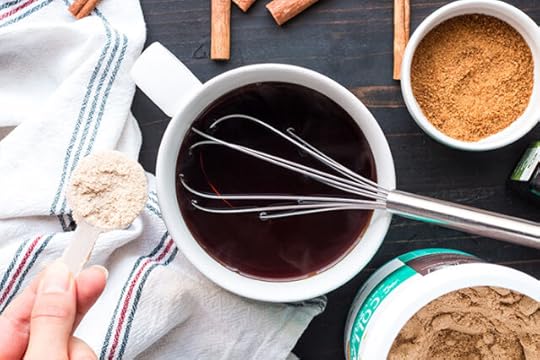
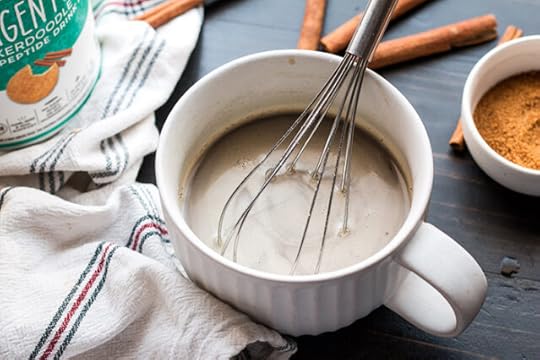
Warm your milk in a small saucepan. To froth the milk, you can use a frothing wand, an immersion blender, or a French press (see tips below for how to froth your milk in a french press).
Pour the coffee into two cups. Pour the frothed milk on top. Sprinkle some cinnamon on top and enjoy. So easy!
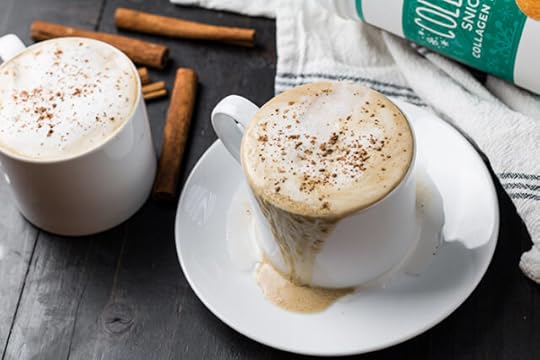
Tips:
Types of milk to use (Here, we used a full fat almond milk.)
Whole Milk
Light canned coconut milk
Full fat store-bought or homemade nut milk.
How to froth milk using a French press, Immersion Blender, and Frother Wand
French press: Warm your milk in a small saucepan until it is warm. Pour it into the carafe and insert the plunger piece. Plunge the milk about halfway up and down vigorously for 10 seconds or so, or until a fine foam forms.
Immersion blender or frother wand: Warm your milk in a small saucepan. Place it into a mug or heat-safe cup. Place the immersion blender/wand into the milk and blend until frothy.

Nutrition Info (for ½ of recipe, will vary based on type of milk used):
Calories: 137
Total Fat: 8g
Total Carbs: 4g
Net Carbs: 3g
Protein: 13g
The post Snickerdoodle Latte Recipe appeared first on Mark's Daily Apple.



December 4, 2020
Weekly Link Love — Edition 109

Research of the Week
Skipping meat may elevate the risk of bone fractures.
Hyperinsulinemia and cancer go hand in hand.
Emotions do not translate perfectly across languages and cultures.
Giving niacin to COVID patients increases recovery.
Not much difference in metabolic markers between pork and chicken eaters.
New Primal Blueprint Podcasts
Episode 457: Keltie Knight: Host Elle Russ welcomes Keltie Knight, an Emmy Award-winning television personality.
Primal Health Coach Radio Episode 86: Laura and Erin chat with Riley Rees, founder of Sofia Health, an online service helping clients find health coaches.
Media, Schmedia
Don’t let bureaucrats tell you what to do. What happens between your car and a moose is entirely your business.
“A desperate nation needs puppies.” Indeed.
Interesting Blog Posts
What Razib Khan is thankful to know about history and genetics.
The importance of vitamin D for T-cell function.
Social Notes
One of the strangest I’ve seen and heard.
I’d swim here.
Everything Else
Ketosis may help fight against COVID.
Things I’m Up to and Interested In
One of the most important films of our time: Sacred Cow, all about regenerative agriculture and the potential power of animal products to save our health and our planet, and it’s free to watch until December 6.
Open letter I found interesting: The one Dave Feldman addressed to the editor of the Journal of Clinical Lipidology.
Eye opening podcast: Frederic Leroy on the implications of The Great Reset.
This was funny: Money increases happiness, psychotherapy does not.
This surprised me: The MMR vaccine may protect against COVID.
Question I’m Asking
Why are there massive networks of prehistoric underground tunnels all across Europe? Craziest answers only.
Recipe Corner
Nigerian beef suya.
Huevos ahogados, or drowned eggs. Similar to shakshuka.
Time Capsule
One year ago (Nov 21 – Nov 27)
Late to the Healthy Living Game? 10 Essential Tips Making the Transition to Better Health – It’s never too late.
6 Mind-Body Approaches for Menopause – Mind is matter.
Comment of the Week
“My wishes to everyone are to enjoy the time with one another, however many that might be and to also enjoy whatever it is that you choose to partake of. As someone who was just diagnosed with this virus and one for whom the sense of taste and smell have been lost for which I do not know if they will ever return, count the blessings you have of whatever it is that you eat.”
-Well said, Terry. I wish you a hasty recovery.
The post Weekly Link Love — Edition 109 appeared first on Mark's Daily Apple.



December 3, 2020
Ask a Health Coach: Sleep, Stress, and the Snooze Button
 Hey folks! Erin is here for another round of Ask a Health Coach. If you’re sleep-compromised, stressed out about carbs, or you’re a chronic snooze button pusher, today’s post is for you. Keep your questions coming in the Mark’s Daily Apple Facebook Group or share them down in the comments section.
Hey folks! Erin is here for another round of Ask a Health Coach. If you’re sleep-compromised, stressed out about carbs, or you’re a chronic snooze button pusher, today’s post is for you. Keep your questions coming in the Mark’s Daily Apple Facebook Group or share them down in the comments section.
Alicia asked:
“I’ve been trying to get up early to exercise, but I always end up hitting the snooze button and falling back asleep. Got any tricks to get myself up on time?”
I love that you’re setting goals for yourself. It proves that you don’t have to wait until New Year’s or (another) Monday to make a change in your life.1 But I get it. Any routine that’s different from your normal one can be a challenge to start, let alone stick with.
The good news is, this is kinda my specialty. I love teaching my clients to nurture their own personal accountability. When you’re responsible for your own actions — and the outcomes of those actions, it puts you in the driver’s seat. You’re in control when it comes to what you’re doing and not doing. It also sends a positive message to yourself that you’re worth it and that this change is important enough for you to make it a priority.
On the flip side, when you just toss a plan out there, cross your fingers, and hope for the best with a lukewarm attitude (and zero consequences), you’re pretty much setting yourself up to fail.
The first rule of accountability? Getting clear on your goals and the reasons why you want to achieve those goals. For your situation, I’d start by asking:
What time am I waking up?
What kind of exercise will I be doing?
What type of equipment or gear will I need?
Where will I be doing it?
How long will I be exercising?
Why does this matter to me?
What will happen if I don’t break my snooze button habit?
Why is all of this important? Because there’s a big difference between people who set goals and those who actually succeed at them.
There’s a great piece of research that shows that having a concrete plan makes you three times more likely to achieve your goals.2 In the study, 248 participants who wanted to build better exercise habits were divided into three groups. One group was asked to track their workouts, one group received motivational information about exercising, and the third group was asked to formulate a plan for when and where they would work out.
More specifically, they were asked to complete the following sentence: During the next week, I will partake in at least 20 minutes of vigorous exercise on (day) at (time) in (place). For you, that might look like:
I will partake in at least 20 minutes of vigorous exercise on weekdays at 5:15am in my bedroom. Or dial it in even more by saying: I will partake in 20 minutes of weightlifting on weekdays at 5:15am in my bedroom.
Another way to increase your odds of getting yourself up on time? Make it easier to do — or harder to not do. James Clear, the quintessential expert on habits says, “the environment that you live in makes it easier to practice unhealthy habits and more difficult to practice healthy habits (…even if you really want to make a change).”
So, if you want to make it easier to work out in the morning, place your clothes, shoes, and weights in a place where you can visibly see them. If you want to avoid smashing the snooze button, consider putting it somewhere out of reach, like the bathroom or a room down the hall. You’d literally have to get out of bed to turn it off.
Practice these techniques and accountability tactics and see what happens. My guess is you’ll have a routine in place before most people are drafting up their New Year’s resolutions.
Tom asked:
“I find that I toss and turn most nights, or I wake up around 3:30 in the morning and have trouble going back to sleep. It’s definitely annoying, but it’s it normal?”
Common, yes. Normal, maybe. Ideal, absolutely not. A lot of my clients struggle to stay asleep, and it’s seemingly more of an issue than actually falling asleep. So, in short, you’re in good company. That said, it’s definitely something you’re going to want to address pronto. Here’s why.
In my opinion, a good night’s sleep is non-negotiable. Sleep is downright essential for performing basic physiological functions, from balancing your hormones and your mood to keeping your immune system strong, which is especially important right now.3
Walking up in the middle of the night could be because of something you ate or drank during the day. Some studies have linked sleep quality to macronutrient intake – meaning you might need more or less carbs to achieve a solid 8 hours of shut eye. And if you’re a coffee drinker, even low levels of caffeine can have consequences. Try keeping a food log for 3-5 days and see if you notice any patterns between what you’re consuming and how you’re sleeping.
You’ll also want to take a look at your pre bedtime rituals.4
1. Minimize screen time. If you need to use a computer, tablet, or phone in the evening, wear blue light blocking glasses or set devices to the “night shift” setting. Artificial light can mess with your circadian rhythm and therefore your sleep cycle.
2. Avoid that late-night drink. A glass of wine or cocktail might help you fall asleep faster, but it can disrupt your REM cycle, leaving you drained, groggy, and likely a little hungover the next day. Alcohol also relaxes the muscles, including the ones in your throat, which might cause you to snore more — or snore louder.
3. Keep your phone out of the bedroom. In addition to the aforementioned blue light situation, scrolling right before bed can lead to weird dreams and stressful fits of sleep. Plus, if you’re one of those people who checks email or social media the second you pop open your eyes, it might be worth exploring taking a break from that routine.
And if these don’t move the needle, consider getting in touch with a medical professional or health coach. Some Primal Health Coaches even specialize in sleep.
Marcelle asked:
“I’m stressing out about the carbohydrates I ate over Thanksgiving. I know a lot of people gain weight around the holidays, but I’ve been working so hard to keep it off. What can I do to off-set all those extra carbs?”
The holidays are always stressful, and, as I’m sure you’ve noticed, this year is no exception. But the extra pressure you’re putting on yourself for what you ate? Why do that to yourself? Adding stress on top of stress only makes your adrenals work harder, encourages your body to pump out more cortisol, and forces your body to store more fat, which if my hunch is correct, likely sends you into a spiral of worry, guilt, and shame.5
So, in a nutshell, the way you’re thinking about your food intake actually has more of an impact than the food itself.6
Also, since when are carbs a whole food group? I don’t know who needs to hear this, but carbohydrates are a macronutrient found in nearly every food, including, but not limited to almonds, apples, asparagus, broccoli, beans, cauliflower, carrots, mussels, oysters, yams, and yogurt.
Even if you served yourself up a plate loaded with meat and veg, you haven’t actually skipped the carbs. If you decided to skip the pumpkin pie with whipped cream and have fresh berries instead? Still carbs. If you passed on dessert altogether and poured another glass of wine? Still carbs.
We tend to criminalize these large subsections of foods — sweeping them all into one bucket. But not all carbohydrates are created equal and, honestly, not all of them are bad. When you become metabolically flexible, you can partake in any kind of food your heart desires and have the peace-of-mind that your body can handle it.7 You can burn fat for fuel. You can burn carbs for fuel. You can go back and forth between metabolizing them with relative ease. So, cut yourself some slack, and appreciate the fact that your body knows what to do.
Now it’s your turn! Drop me a few questions in the comments below.
References https://today.yougov.com/topics/lifestyle/articles-reports/2020/01/02/new-years-resolutions-2020-health-financehttps://pubmed.ncbi.nlm.nih.gov/14596...https://www.marksdailyapple.com/sleep-tips-video/https://www.mayoclinic.org/healthy-lifestyle/stress-management/in-depth/stress/art-20046037https://psychologyofeating.com/mind-over-food/https://www.marksdailyapple.com/definitive-guide-to-metabolic-flexibility/
The post Ask a Health Coach: Sleep, Stress, and the Snooze Button appeared first on Mark's Daily Apple.



December 2, 2020
Brain Benefits of Playing Instruments
 One of my biggest inspirations was my late father, Laurence Sisson. He supported our family as a painter, primarily water color paintings of New England nature scenes. His work ethic was insane as was his creative genius. But my most salient memories of him are not those spent in the art studio watching beautiful representations of nature’s glory appear before my eyes. No, what I remember most are the evenings spent around the piano.
One of my biggest inspirations was my late father, Laurence Sisson. He supported our family as a painter, primarily water color paintings of New England nature scenes. His work ethic was insane as was his creative genius. But my most salient memories of him are not those spent in the art studio watching beautiful representations of nature’s glory appear before my eyes. No, what I remember most are the evenings spent around the piano.
He was also a great jazz pianist, and often took paying work as a musician when the times demanded it. During holidays, he’d play the classics. On quiet afternoons, he’d noodle on the keys. Piano music was the backdrop of the house. And, I’m convinced, playing that piano kept his brain nimble to the very end.
Music and Brain Function
If you spend any time at all on social media, you’ve probably seen the videos of otherwise unresponsive Alzheimer’s or Parkinson’s disease patients lighting up when a favorite piece of music from their younger days plays.
There’s this one, where an old man in a nursing home on his last legs comes to life. After listening to some of his favorite music, he becomes incredibly responsive, answering questions about himself and his life. Music gives him access to the parts of his brain that were previously shut out, at least for a brief moment.
The most recent one I saw is of a former New York City prima ballerina with Alzheimer’s disease. When she hears “Swan Lake,” she motions to raise the volume and then launches into the choreography from her chair—the same dance she mastered and performed over 50 years prior. Even as I’m writing this and picturing it, I feel tears welling up from the beauty of the moment.
Most of you reading this aren’t in that dire of a cognitive situation, but you can probably relate to the effect music can have on our brains. We’ve all felt the power of music. When that song comes on and catapults you back to some bygone era of your youth. When you hear an album and actually smell the smells, taste the tastes, and feel the emotions it evokes in you. Something powerful is happening in the brain, and we shouldn’t wait til degeneration sets in.
If we know there are certain lifestyle, dietary, and behavioral modifications that can improve the outlook of a patient with dementia, then enacting those changes before dementia arises will be even more powerful and effective at staving it off. Music is one possibility.
And if merely listening to music can have that effect on cognitive function, even severely degenerated cognitive function, what can playing music—creating it with your own mind—do for it?
Playing an Instrument for Brain Health
We actually have evidence that playing an instrument is protective of brain health and function.
In one recent study, researchers asked 23 former orchestral musicians if they or any musician they knew had dementia. Dementia rates among the queried musicians were nonexistent, nor did any of them know other musicians who had the disease.1
Another study found that among older cognitively intact adults, those with a history of musical training had better episodic memory scores.2 Those who could read music had better episodic memory and better semantic verbal fluency. Notably, researchers controlled for IQ, so this wasn’t just an intelligence test.
Another earlier study had similar results, finding that older adults with at least 10 years history as a musician performed better on a battery of cognitive tests than those with no experience.3 They didn’t control for IQ but they did control for education attainment, which is a decent barometer of intelligence (though exceptions definitely exist).
What about more direct trials? Can we show that playing instruments can actually elicit changes to the brain’s function?
Recent research shows that music practice, which forces our brains to work in a completely different way than normal waking reality, is an important contributor to neural plasticity. Even just two weeks of piano practice elicits neuroanatomical changes to the auditory cortex in non-musicians.4 It can also reduce or prevent the age-related degradation of Broca’s area, a section of the brain partially responsible for speech production that’s often damaged in dementia.5 The same protective effect has been seen in the auditory cortex, which controls speech recognition among other things, of aging musicians.6 All these changes spell big potential benefits for people with age-related cognitive dysfunction, but there are also benefits for younger brains too.
Research has found that children who engage in musical training show increases in IQ, verbal memory, and linguistic ability, even when the control group is composed of kids with otherwise similar backgrounds (socioeconomic status, academics, etc) except for the music training.78910 This doesn’t prove that playing instruments changes the brain or improves its function, but it’s quite suggestive.
Playing an Instrument to Hit Flow State
Flow doesn’t happen when you struggle. It doesn’t happen when you trip over your own fingers or have to concentrate so hard you start sweating and stressing. Flow happens when you know the material and the instrument so well that you fuse with it and become one. When you lose yourself in the music and all sense of time. If you’re learning an instrument, you probably won’t reach flow very reliably. To trigger a flow state, you should play something you’re good at. Something that you can lose yourself in, whether that’s a Chopin prelude or a simple hand drum beat. It all depends on your skill level.
But hitting that flow state is one of the major brain benefits of playing an instrument. It’s instant mindfulness, where you turn off the churning brain for once and simply exist in the present moments as they unfold. If you’ve wanted to meditate but haven’t had any luck with typical sitting meditation, get to a place where you can groove or jam or play on an instrument for an extended period of time.
Playing an Instrument to Reduce Stress
One of the biggest impediments to brain function is chronic stress. A little stress can help—if anything, acute spikes in stress hormones like adrenaline or cortisol can momentarily heighten cognition and awareness. But chronic elevation of these hormones destroys cognition. Studies show that playing music can reduce stress levels.11 Furthermore, anything that gets you into the flow state will lower stress, almost as a rule. I could elaborate with even more extensive citations, but instead I’ll tell you about the drums.
I might not be that good, but man is my electric drum kit I keep in the office a stress release. I put earbuds in, fire up a rock song on my iPad, then put the headphones to the drum kit over that, and wail away for an hour and a half almost every night. A legend in my own mind (the only mind that matters). If you walked into the room while I was doing this, all you would hear is Pita pit a pitta TapTap softly. But inside the headphones, I’m killing it. Highly recommended.
Playing an Instrument for Happiness
No, that isn’t sexy. It’s not going to sell any online e-courses. You won’t get clout and “happy” can’t be quantified, even if you start citing neurochemicals. But happiness is . When you boil things down, most people will name “be happy” as a major long-term goal. It’s not everything, you need meaning and drive and a mission as well, but moment-to-moment happiness really does matter for brain health.
Playing an Instrument Is Magic
If magic exists, music fits the bill. It can change your emotions on a dime. It can conjure up vivid memories, even those previously calcified and inaccessible via normal modes of cognition. It can capture and even alter the energy of the room. It makes people move their bodies without realizing or wanting it. Music can’t be touched or felt, only heard; it’s real but intangible, abstract but verifiable. And if you are making the music and wielding the instrument, you become the magician.
Whatever you do, don’t wait any longer. Pick up that instrument you’ve been thinking about and get after it. Over the last few years I’ve picked up the piano and have been dabbling in the drums, but man, there’s a HUGE difference between trying to learn at my age and trying to learn as a kid. You want to talk about compound interest, learning music (or any skill, really) as a child is a relatively small initial investment that quickly accumulates value. And most importantly, it never loses value. You learn the thing when your brain is still physically developing and the thing becomes embedded in the physical structure of your brain. It’s almost impossible to forget a skill like that. I wish I had that with music. If you have that opportunity, take it.
Do you play any instruments? How has it affected your brain health, as far as you can tell?
Thanks for reading, everyone. Take care!
References https://pubmed.ncbi.nlm.nih.gov/15636467/https://pubmed.ncbi.nlm.nih.gov/24375575/https://pubmed.ncbi.nlm.nih.gov/21463047/https://www.ncbi.nlm.nih.gov/pubmed/18815249/https://www.ncbi.nlm.nih.gov/pubmed/12414299/https://www.ncbi.nlm.nih.gov/pubmed/21910546https://www.ncbi.nlm.nih.gov/pmc/articles/PMC2948283/https://www.ncbi.nlm.nih.gov/pubmed/15270994/https://www.ncbi.nlm.nih.gov/pubmed/12959510/https://www.ncbi.nlm.nih.gov/pubmed/18832336/https://pubmed.ncbi.nlm.nih.gov/24983262/
The post Brain Benefits of Playing Instruments appeared first on Mark's Daily Apple.



December 1, 2020
Basic Cooking Skills for Rookies
 It’s easy to ignore your lack of rudimentary cooking skills when you order pizza or get takeout every night. When people switch to Primal or keto diets, they usually find themselves spending considerably more time in the kitchen. On the plus side, they’re better able to control ingredient quality and the macronutrient breakdown of their meals. For better or worse, this also forces them to confront their lack of culinary prowess.
It’s easy to ignore your lack of rudimentary cooking skills when you order pizza or get takeout every night. When people switch to Primal or keto diets, they usually find themselves spending considerably more time in the kitchen. On the plus side, they’re better able to control ingredient quality and the macronutrient breakdown of their meals. For better or worse, this also forces them to confront their lack of culinary prowess.
Preparing two or three homemade meals per day can be daunting if you’re accustomed to mostly grabbing prepackaged or restaurant fare. As with any other skill, though, you learn by starting with the basics, practicing often, and building proficiency as you go. Your meals don’t have to be elaborate, your technique perfect, or your dishes artistic. They just have to taste good.
Today I’m going to nominate some skills and dishes that I think every beginner should learn. Chime in in the comments and let me know what else you would put on the list.
Where to Start
First, some basics:
Start by following other people’s recipes. Don’t try to wing it if you don’t know what you’re doing. Find one or two cookbooks or blogs you like, and work your way through them. To learn your way around a kitchen, Cook’s Illustrated and America’s Test Kitchen books are tried and true. My favorite book for artful yet practical kitchen inspo is Samin Nosrat’s Salt, Fat, Acid, Heat.
Get good knives and keep them sharp. Watch some YouTube videos to learn basic knife skills. Everyone should know how to chop an onion. Start there.
Season your food, for goodness sake. I have a theory that most people who think they are bad cooks are mostly just boring cooks. (That, and they overcook their meat, but we’ll get to that.) Salt is your friend. You should have a decently stocked spice rack. Tell me in the comments what spices you use most. Mine are cumin and turmeric.
Just go for it! As with anything else, you get better by doing it. Stick to simple recipes at first, then get more adventurous as you become more confident.
Chicken
I firmly believe that everyone should know how to roast a whole chicken. A fragrant, golden chicken feels like true kitchen mastery, yet it’s so simple. Ina Garten taught me (not personally, but you get it), or start with this Perfect Roasted Chicken recipe.
When you roast a whole chicken, you end up with a carcass. This is great news because you should also know how to make your own bone broth. It doesn’t matter whether you use the stovetop, slow cooker, or pressure cooker method. Either way, it couldn’t be easier to stock your freezer (no pun intended) with jars of homemade bone broth. Then you always have some on hand to make soups, stew, chili, or just to drink.
When it comes to making chicken breasts or thighs, I usually opt for thighs because they are more forgiving. Breasts have a tendency to become dry and disappointing. The secret is to brine your chicken breasts, especially if you’re baking them or throwing them on the grill. (You can also brine thighs or whole chickens, or indeed any poultry or lean meat, but it’s particularly life-changing with chicken breasts, in my opinion.) Here’s how I do it:
Step-by-step brining
Boil two cups of water.
Remove it from the heat and stir in 1/4 cup of sea salt until dissolved.
Transfer the salty water to a large glass bowl. Top it off with ice water to cool the solution so you don’t poach the chicken. Give it a stir. If you have any fresh herbs and garlic cloves on hand, you can throw them in now, but it’s not required.
Add the chicken, making sure it’s covered by water. Let it sit for 20-30 minutes on the counter (yes, it’s fine), or stick it in the fridge for up to an hour.
Remove the chicken and cook according to your recipe, but don’t add more salt!
Chicken recipes to try:
Devyn’s Grilled Marinated Chicken (MDA)
Cracklin’ Chicken (Nom Nom Paleo)
Mayo Roasted Chicken (Primal Kitchen)
Vegetables
Please, I’m begging you: unless you are making soup, don’t boil your vegetables. Steaming is acceptable, but for truly delicious cooked vegetables, sauté or roast them.
With both sautéing and roasting, avoid these three rookie mistakes:
Not using enough fat or oil. Vegetables need lubrication to avoid sticking to the pan, and oil allows your roasted vegetables to develop those scrumptious crunchy bits. When sautéing, add enough oil/fat to just cover the bottom of the pan. For roasting, use enough to coat the vegetables when you toss them, but not so much that they end up floating in a pool of oil.
Overcrowding the pan. Give the veggies room to breathe. Use multiple roasting pans or sauté in batches rather than allowing them to overlap, unless you’re stir-frying.
Playing it too cool. Hot = browning, browning = flavor. When it comes to roasting, 375°F (190°C) is as low as I’ll go, but really, I rarely roast below 425°F (220°). If you’re roasting multiple types of vegetables at one time, it’s best to keep them separated in case they get done at different rates.
For masterful sautéing, preheat your pan over medium-high heat without any fat or oil. When it’s nice and evenly hot, add the fat, then add the vegetables. Sauté over medium to medium-high heat.
In general, I favor sautéing for softer vegetables and that cook more quickly—think mushrooms, zucchini, summer squash, fresh green beans, bell peppers—and roasting for harder vegetables like winter squash and the cruciferous Brussels sprouts, broccoli, cauliflower, or romanesco. These aren’t hard-and-fast rules. You can certainly roast zucchini or peppers and onions, for example.
Two more tips:
Take the time to cut your vegetables into approximately uniform pieces so they cook at the same rate.
Don’t be too stir-happy when sautéing. If you want your vegetables to brown nicely, let them sit undisturbed for a few minutes before stirring and repeating.
Vegetable recipes to try:
Easy Roasted Winter Vegetables Recipe (MDA)
Grilled Greek Summer Veggies Recipe (MDA)
Balsamic Roasted Brussels Sprouts (MDA)
Also check out Mark’s 8 Tips for Cooking Vegetables
Steak
Steak lovers have strong feelings about how to cook the perfect steak. You’ll have to experiment with different methods and cuts to find what you prefer. I personally like to cook NY Strips on very hot cast iron, season my steak before cooking with only coarse salt, and flip it frequently. Other people swear by reverse searing, which is also fantastic. Still others will only cook steak on a grill, as in Mark’s Grilled Steak.
I’m not going to tell you how to cook your steak, but I will suggest that if you prefer your steak well done, you shouldn’t admit that aloud unless you want some serious ribbing. Just saying. Use a meat thermometer to check the temperature of the steaks and take them off the heat when they are 5 to 10 degrees below your target temp:
Rare: 120-125°F (45-50°C)
Medium-rare: 130-135°F (55-60°C)
Medium: 140-145°F (60-65°C)
Medium-well: 150-155°F (65-70°C)
Well: >160°F (>70°C)
Keep in mind, no matter what cut and method you use, you should let your steaks rest for 5 to 10 minutes before cutting into them. During that time, the internal temperature of the steak will rise 5°F or so.
Eggs
Omelets are always on lists of kitchen skills everyone should have, but I disagree. Omelets are fussy. Scrambles are much easier and just as delicious. In any case, though, I do think that Primal + keto eaters should have some egg skills in their repertoires. I’d start with the following:
Scrambled eggs. Here’s how to make the most amazing scrambled eggs:
Heat a skillet over medium-low heat.
Melt some butter in the skillet and crack the eggs into the skillet without stirring. (You can also separate the whites and yolks here, but it’s a more advanced maneuver.)
When the whites are about halfway cooked, start pushing them around with a spatula, avoiding the yolks.
When the whites are nearly done, take the pan off the heat, break the yolks, and fold the yolks and whites together. Keep stirring gently until the eggs are cooked to your liking. They should be creamy, but if you just can’t handle soft eggs, put the pan back on low heat and finish to your liking.
Hard-boiled eggs. The truth is, I never boil eggs anymore. For hard-cooked eggs, I either use the Instant Pot (easiest!) or steam them. You won’t lose eggs to cracking this way.
The Instant Pot 5-5-5 method is foolproof: Cook eggs for 5 minutes using the Egg or Manual function, let the pressure release naturally for 5 minutes, then release the remaining pressure and move the eggs to an ice bath for 5 minutes. Voila.
Or, boil a couple of inches of water in a pan and place a steamer basket inside. Steam the eggs for 7 to 10 minutes depending on how you like the yolk, then transfer them to an ice bath to cool.
Egg muffins. Like this recipe.
Egg recipes to try:
Instant Pot “Sous Vide” Egg Bites (MDA)
Perfect 4-Ingredient Keto Deviled Eggs (Primal Kitchen)
Sun-Dried Tomato Bacon Frittata with Garlic Aioli (Primal Kitchen)
This should be a good start for any new cook. What else would you add? Which books are must-reads for kitchen beginners? Skills or dishes that everyone should have in their arsenal?
The post Basic Cooking Skills for Rookies appeared first on Mark's Daily Apple.



November 30, 2020
How to Recover from Holiday Overindulgence
 So, you overdid it…or just ate something that doesn’t work with your body. Maybe you didn’t binge per se but you abandoned the original plan and now you’re feeling the pain. You ate, maybe more than you intended, maybe differently than you intended.
So, you overdid it…or just ate something that doesn’t work with your body. Maybe you didn’t binge per se but you abandoned the original plan and now you’re feeling the pain. You ate, maybe more than you intended, maybe differently than you intended.
Non-Primal foods were consumed – perhaps many of them or just a few in larger than planned quantities. Non-Primal and sub-Primal drinks were imbibed beyond the point of intention. And now the consequences are playing out. You’re stuck in a bloated, sloth-like, catatonic state. You’re nursing a major headache with every shade shut and the covers over your head wishing in a rather non-seasonal mindset that your children would take the noise to some distant corner of the neighborhood. Maybe you’ve taken up residence in the bathroom.
In a less dramatic scenario, perhaps you’re just pushing yourself through the day because you notice your energy is off, your digestion not up to full speed, your mood not quite as equanimous as usual. Whether you feel it was worth it or not, who wouldn’t want to reverse the course of misery itself after the fact?
Think of it this way: with health comes sensitivity to what’s unhealthy.
I’ll admit I don’t really get into cleanses or detoxes. That said, I do think we can help our bodies in their own miraculous processes get back on track – or at least get out of their way while they undo the damage. With a little time and care, we can recover and move on not too much worse for the wear. The healthier we eat and live on a daily basis, the better condition we’re in to weather these upsets. Unfortunately, however, the cleaner we eat the other 364 days of the year, the more we might feel a significant detour in our diet. That heaping plate of mashed potatoes with processed gravy product might have barely registered pre-Primal. Today it can leave you with indigestion and noxious gas for a good 36 hours.
If you’re looking to feel better after a big day (or season) of non-Primal eating, consider these modest proposals for what ails you.
Commit to a morning fast.
Conventional wisdom says eat normally after a holiday binge, but the body says differently. (Guess which one I’m inclined to heed.) Maybe the digestive fallout makes fasting a given, but even if you’re able to eat, give your body a break until early or even mid-afternoon. CW thinks if you go for a few hours without eating you’re sure to throw yourself head on into a major binge. That’s not the case for most Primal folks. Give your body the time it needs to take care of the residuals from the day before.
Drink some tea.
Lay off the food for a while, but go ahead and hydrate. Resist, however, Grandma’s suggestion to down a shot of hard booze. (Hands for how many times folks have heard this from family or friends?) Research has shown alcohol actually slows gastric emptying.1 One study that compared the effects of tea, wine and schnapps on gastric emptying showed that tea won hands down.2 Although the tea in the study was simple black tea, consider something without caffeine. (Your body has enough to contend with at the moment.) Chamomile can relax your nerves and your digestive tract, while peppermint can soothe an upset stomach. Opt for something other than mint, however, if heartburn is an issue. Keep in mind you shouldn’t down massive quantities of water (another common recommendation you’ll hear from conventional sources). You don’t want to drink so much that you end up diluting the gastric juices that are trying to do their job.
Try bitters.
There’s not much in terms of research (to be found in English anyway), but this is one age-old home remedy that will likely help. The folk wisdom that recommends schnapps, for example, is generally based on herb/bitter based schnapps formulations. The remedy is in the herb – not the alcohol.
Avoid antacids and acid reducing medication.
Your gastric juices are there to digest your food. If your food is slow to digest and feels like a rock in your stomach, does countering or reducing the natural acids that will break things down and move them along make any logical sense? Steer clear of these “remedies” and let your body do its thing.
Take a good helping of probiotic.
Whatever you ate likely did a number on your bacterial profile. A recent study, in fact, shows it only takes a few days to effect substantial change (about the same duration as most holiday visits to non-Primal relatives).3 While our guts are amazingly adaptable, that holiday binge might not be doing it any favors. Help replenish your healthy gut environment with a good probiotic supplement.
Relax yourself.
If you’re a bound up bag of aches and nerves, it doesn’t do your digestive process (or mentality) any good. Relax. Take a hot bath or shower. Turn up the heat, put on some relaxing music, and put a hot water bottle on your stomach and heated rice sock around your neck and shoulders.
Get some help from enzymes.
Especially if you ate something that you don’t tolerate well, try a quality enzyme supplement. (If you don’t have one on hand, bribe a family member or friend to visit your local health food/co-op store and search for one.) Avoid anything that contains sugar or artificial colors, fillers, etc. This is not the time for chemical additives.
Move but don’t push it.
You might not be up for your regular weight lifting session, but resist the urge to totally park it on the couch all day. Research shows that slow, low-level moving like walking aids gastric emptying.4 Those residuals of your holiday meal will move along more quickly if you get it in gear. There’s motivation to get up!
Don’t underestimate the power of fresh air and sun.
Especially if you’re feeling nauseated, fresh air can pull you out of your misery. Add sun, and you might just have a new lease on life. Sure, you may feel just as crappy an hour after you go back inside, but stay outside as long as you can to give yourself some relief.
Eat a small Primal meal at the end of the day.
Avoid sending your insulin spiking multiple times that day by grazing. Fast as long as it’s productive and comfortable, and then enjoy a modest Primal meal. When you do, choose something that will keep you satisfied for the rest of the night without taking up too much space/energy in an already sensitive stomach. Some vegetable-based fiber and protein should do the trick.
Go to bed early.
You’ve been through the wringer. However lethargic you’ve felt, certain body processes have been on overdrive or have been working harder to compensate for the food related stresses. Give into your body’s intuitive demands, and hit the sack early. Tomorrow is another Primal day.
Have you had any post-indulgence days that left you seeking relief? What’s works for you? Let me know your thoughts, and thanks for reading, everyone.
References https://www.ncbi.nlm.nih.gov/pubmed/23420574https://www.ncbi.nlm.nih.gov/pubmed/21156747https://news.yahoo.com/gut-microbiome-changes-rapidly-diet-173000799.htmlhttps://www.ncbi.nlm.nih.gov/pubmed/18392240
The post How to Recover from Holiday Overindulgence appeared first on Mark's Daily Apple.



November 26, 2020
How to Enjoy Your Holiday Feast, Guilt-Free
 I think everyone can agree that things look a lot different this year. We’re planning smaller holiday gatherings with just our immediate families.1 There are restrictions at stores and restaurants. And, in some places, limited supplies of groceries and household items.
I think everyone can agree that things look a lot different this year. We’re planning smaller holiday gatherings with just our immediate families.1 There are restrictions at stores and restaurants. And, in some places, limited supplies of groceries and household items.
One thing that looks the same (at least with my health coaching clients) is the internal dilemma of whether or not they’re going to stick with their healthy eating habits or say “Screw it!” and dive into a plate of real bread stuffing, cornstarch-thickened gravy, and multiple slices of pecan pie.
On one hand, there’s the philosophy that holidays are a special occasion and should be treated as such. And that includes all the traditional carb-laden goodies. On the other hand, there are people who are 100 percent committed to their Primal lifestyle and prepare their holiday feast accordingly.
Let me emphatically state that there’s no right or wrong answer here.
Just Don’t Call it a ‘Bad Food Day’
Honestly, I don’t care if you indulge in several servings of green bean casserole or marshmallow-crusted sweet potatoes. What I do care about is the level of guilt you carry around with you after doing so.
What does guilt have to do with food? Guilt is the feeling that you’ve done something wrong. At a young age, most of us are taught the difference between right and wrong. So, in a general sense, you might feel guilty if you stole something, hurt someone, or got caught up in a lie. On the other hand, you might have been rewarded or praised for doing something right (i.e. getting good grades, helping a neighbor, doing chores without being asked).
Examples of Food Guilt:
I shouldn’t have another piece
Dessert/bread/wine is unhealthy
Once I start, I can’t stop
I’ve totally blown it
I don’t want to see the scale tomorrow
Diet culture tells us to feel bad if we overeat or indulge in *forbidden* foods. It says that a higher number on the scale is equal to lower self-worth. Don’t get me wrong, certain foods come with consequences. Depending on your bio-individuality, foods with higher amounts of sugar, industrialized oils, and artificial ingredients might leave you feeling foggy, fatigued, bloated and on the fast-track to chronic disease. But moralizing foods for their good vs bad qualities always backfires.
Metabolism is Influenced by State of Mind
In addition to the heavy emotional baggage you have to carry, deeming certain foods as negative actually discourages metabolic activity.2 It all starts in your hypothalamus, which processes senses, emotions, and biological functions like hunger. When you feel guilty about what you’re eating, the hypothalamus transmits signals that slow your digestion and cause your body to store more calories as fat versus burning them for energy. In theory, saying to yourself “this will make me fat” becomes kind of a self-fulfilling prophecy.
On the flip side, when you enjoy food as you’re eating it, the hypothalamus releases pleasure signals that stimulate digestion so that you thoroughly break down food and more effortlessly burn off the calories.
So, it’s not just what you’re eating, it’s what you’re thinking about what you’re eating.
Not only that, negative thoughts can lead to other compensatory behaviours. In this study, researchers analyzed data from 3,177 people, examining the differences between those who experienced food guilt and those who didn’t.3 Across the board, they found that the food guilt group had higher scores in the areas of binge eating, low self-esteem, isolation, and avoidance coping.4
You Can’t Just Let Go of Food Guilt, Can You?
If you’re wired to see foods as good or bad, it’s going to take some unraveling, but it’s completely possible. It’s also completely worth it so you’re not white knuckling it through the holidays. Or worse, yet, beating yourself up about it for days. And as you let go of good guilt, there’s a good chance you’ll find yourself eating more intuitively. Here’s how to get started:
Step 1: Challenge your food rules.
We all have them. It’s that little voice inside that says, “you shouldn’t have that” or “stop grazing” or “that’s going to go right to your thighs.” This is all based on your stories or beliefs you created through your experiences growing up. Once you’ve acknowledged one of your rules, confront it. You always have a choice to decide if it’s valid or just reflecting old, outdated programming and no longer serves you.
Step 2: Be curious vs judgmental.
How often are you judging yourself? And not just when it comes to what you eat? You might be so used to being in judgment mode that you don’t even realize when you’re doing it to yourself – or someone else. Try, instead, to be curious. Ask yourself why you think a certain food is bad or where these judgements are coming from. You might find that the beliefs you have aren’t even your own. Also, learn to approach these situations from a growth mindset rather than a fixed mindset. You can read more about how to do that here.
Step 3: Have a plan.
Nine times out of ten, if you walk into a holiday feast hungry, you’re going to choose foods you might not choose otherwise. That’s why it’s so important to have a plan in advance. My go-to strategies for avoiding impulse binging are to: prioritize protein and fat, make breakfast your most calorically dense meal of the day, and always answer hunger with a meal. You might still indulge, but you’ll feel better about your decision if your body and brain are satiated.
Step 4: Know your triggers.
If you know you can’t pass up a bowl of candy when you’re hungry, don’t put out a bowl of candy (or don’t show up hungry). If you cope with stress by eating or drinking, find healthier ways to decompress. Getting clear on what triggers you is a game-changer in situations like this. And it can save you hours — or even days of grief afterwards.
Step 5: Practice self-compassion.
Being kind to yourself is a skill not everyone has. That’s why it’s so important to practice it on a regular basis. Self-compassion requires empathy and the ability to be fully present with yourself and whatever feelings you’re experiencing — without running away, hiding, or diving headfirst into a bag of M&Ms. You never need to be punished for your actions, so resist the urge to “diet harder” by eating bland chicken breast for three days straight or committing to a steady stream of chronic cardio for the next week. You deserve better.
How to Have a Guilt-Free Feast
It doesn’t matter if you’re paleo, keto, vegan, whatever. Letting go of food guilt is the healthiest move you can make. Use these steps to get to the bottom of your food fixation and get ready to enjoy your holiday feast guilt-free.
Challenge your food rules
Be curious vs judgmental
Have a plan
Know your triggers
Practice self-compassion
Do you experience food guilt? What strategies work for you?
References https://news.llu.edu/health-wellness/how-celebrate-holidays-safely-during-flu-season-and-covid-19https://psychologyofeating.com/mind-over-food/https://www.prweb.com/releases/remorseful_for_every_morsel_new_study_looks_at_the_psychological_complexities_of_food_guilt/prweb16191634.htmhttps://www.psychologytoday.com/us/blog/in-practice/201305/avoidance-coping
The post How to Enjoy Your Holiday Feast, Guilt-Free appeared first on Mark's Daily Apple.



November 25, 2020
Primal Gift Guide 2020
 People rag on the holiday season for being too commercial. You can certainly go too far in that direction, but there’s absolutely nothing wrong with giving meaningful gifts to people you care about. In fact, that’s one of the kindest acts a person can do. Today’s Primal gift guide does not consist of pointless consumerist pap that your giftees will enjoy for a day or two until the newness wears off and they move on to the next thing to spend their money on. These are useful gifts. Gifts that enhance life, that further our relationships, that expand our culinary horizons, that compel us to go out and experience the world. There’s no shame in celebrating the holidays in this manner, because these are good gifts given out of love, fellowship, and friendship—all of which embody the true meaning of the season.
People rag on the holiday season for being too commercial. You can certainly go too far in that direction, but there’s absolutely nothing wrong with giving meaningful gifts to people you care about. In fact, that’s one of the kindest acts a person can do. Today’s Primal gift guide does not consist of pointless consumerist pap that your giftees will enjoy for a day or two until the newness wears off and they move on to the next thing to spend their money on. These are useful gifts. Gifts that enhance life, that further our relationships, that expand our culinary horizons, that compel us to go out and experience the world. There’s no shame in celebrating the holidays in this manner, because these are good gifts given out of love, fellowship, and friendship—all of which embody the true meaning of the season.
That said, let’s get to the gifts!
Note: I’ve broken these down into Gifts for Men, Gifts for Women, and Gifts for Kids, but don’t let that tie you down. I happen to personally enjoy many of the gifts mentioned below in the “women” and “kids” sections.
Gifts for Men
Camp Chef Lumberjack Over the Fire Grill
 A large sturdy steel grill with folding legs, so you can place it directly over the fire to cook right on the grill or use the grill as a stand for your pan or griddle. I’ve used these types of grills to cook fresh fish in the sand over a bed of coals as the sun dips down below the horizon, and there’s nothing like it. Anyone who loves to grill or cook in the great outdoors needs this.
A large sturdy steel grill with folding legs, so you can place it directly over the fire to cook right on the grill or use the grill as a stand for your pan or griddle. I’ve used these types of grills to cook fresh fish in the sand over a bed of coals as the sun dips down below the horizon, and there’s nothing like it. Anyone who loves to grill or cook in the great outdoors needs this.
Ken Onion Knife Sharpener
 Ever go to farmer’s market and there’s the knife sharpener with a Honda generator going and his belt sander cranking out razor edges on santoku blades that haven’t been sharpened in 5 years? There’s a smaller, consumer version available known as the Ken Onion knife sharpener. I don’t have one myself but know a few people who swear by them. They don’t provide the meditative effects of spending 45 minutes on the sharpening stone, but the learning curve is quite moderate. You get in with a dull knife and out with a sharp one in a couple minutes.
Ever go to farmer’s market and there’s the knife sharpener with a Honda generator going and his belt sander cranking out razor edges on santoku blades that haven’t been sharpened in 5 years? There’s a smaller, consumer version available known as the Ken Onion knife sharpener. I don’t have one myself but know a few people who swear by them. They don’t provide the meditative effects of spending 45 minutes on the sharpening stone, but the learning curve is quite moderate. You get in with a dull knife and out with a sharp one in a couple minutes.
Butcher Box Free Steak Pack
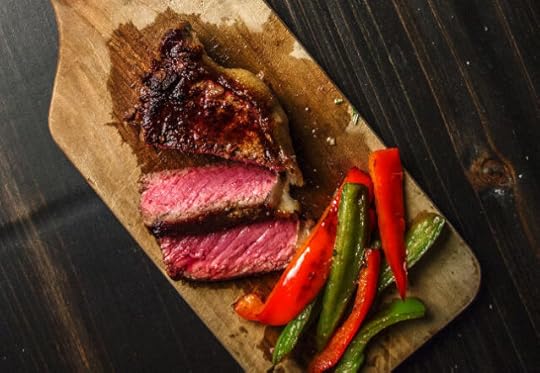 In case you aren’t aware, Butcher Box delivers grass-fed beef, pasture-raised pork and chicken, and wild caught fish to your doorstep. This is meat and fish whose provenance you can be assured of. What could be better than that? I for one am a huge fan of high quality meat appearing at my house.
In case you aren’t aware, Butcher Box delivers grass-fed beef, pasture-raised pork and chicken, and wild caught fish to your doorstep. This is meat and fish whose provenance you can be assured of. What could be better than that? I for one am a huge fan of high quality meat appearing at my house.
It’s also the perfect gift for any meat lover. And if you use this link, you get to add on 2 NY strips and 4 top sirloin steaks for free to whatever package you order.
Adaptogenic Calm
 Men, you need this. If you’re anything like I was—a driven, type A personality, someone who accepts stress even when objectively I shouldn’t be involved and certainly aren’t culpable—you need to get a handle on your stress. You need to learn how. And that’s what Adaptogenic Calm does: it trains your body to adapt to the stress. It helps calm down your stress response system so you’re not overreacting to the little things that don’t matter. This allows you to respond to the stressors that do matter. Adaptogenic Calm is not a blanket snuffing out stress no matter the source. It helps you adapt in either direction.
Men, you need this. If you’re anything like I was—a driven, type A personality, someone who accepts stress even when objectively I shouldn’t be involved and certainly aren’t culpable—you need to get a handle on your stress. You need to learn how. And that’s what Adaptogenic Calm does: it trains your body to adapt to the stress. It helps calm down your stress response system so you’re not overreacting to the little things that don’t matter. This allows you to respond to the stressors that do matter. Adaptogenic Calm is not a blanket snuffing out stress no matter the source. It helps you adapt in either direction.
Gifts for Women
Pique Ode to Tea gift box
 Pique tea crystals distill the essence of tea leaves through a unique proprietary process known as “cold brew crystallization” that maximizes the extraction of antioxidant compounds and makes your job as tea quaffer easier. Because let’s face it: actual tea is a fickle, finicky beast. Each tea requires specific temperatures and steeping times to extract the good stuff while preserving the taste. The beauty of this product is that you don’t have mess around with all that if you don’t want to.
Pique tea crystals distill the essence of tea leaves through a unique proprietary process known as “cold brew crystallization” that maximizes the extraction of antioxidant compounds and makes your job as tea quaffer easier. Because let’s face it: actual tea is a fickle, finicky beast. Each tea requires specific temperatures and steeping times to extract the good stuff while preserving the taste. The beauty of this product is that you don’t have mess around with all that if you don’t want to.
Included with the broad selection of tea crystals is a music box that plays Beethoven’s “Ode to Joy” every time you open it, along with a guide containing ancient and hidden secrets for unlocking your full potential as a human.
Breville Control Grip Immersion Blender
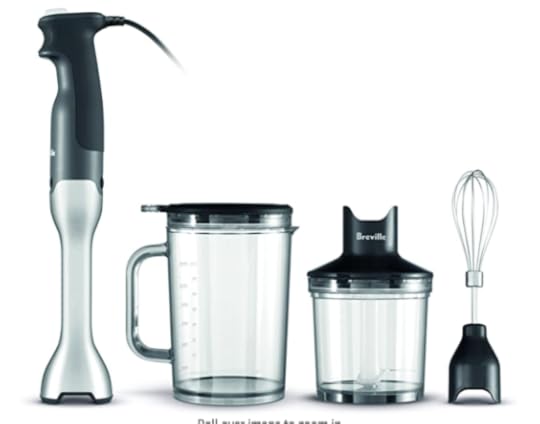 I’m sure better, stronger immersion blenders exist for more money, but I have never met this blender’s equal in the home kitchen. It’s not inexpensive by any means. It is effective, though, and well worth the money. Cheaper immersion blenders require liquid to start. This does not. You can make some incredible whipped butternut squash, for example, just by adding a touch of cream and butter to steamed squash and putting the blender to work.
I’m sure better, stronger immersion blenders exist for more money, but I have never met this blender’s equal in the home kitchen. It’s not inexpensive by any means. It is effective, though, and well worth the money. Cheaper immersion blenders require liquid to start. This does not. You can make some incredible whipped butternut squash, for example, just by adding a touch of cream and butter to steamed squash and putting the blender to work.
Earthing or Grounding Sandals
 Grounding is legit. I don’t know exactly what’s happening, but there’s something special about connecting yourself to the earth—ideally barefoot on bare ground. However, going barefoot isn’t always in the cards. Sometimes you need shoes. Sometimes society expects you to wear them. And so the Grounded Athlete, a one-man operation, has created a Tarahumara-style sandal with a piece of copper in the sole that interfaces with the earth and connects to silver threading that runs through the strap attached to your foot. You can hike and run and train in these things while staying connected.
Grounding is legit. I don’t know exactly what’s happening, but there’s something special about connecting yourself to the earth—ideally barefoot on bare ground. However, going barefoot isn’t always in the cards. Sometimes you need shoes. Sometimes society expects you to wear them. And so the Grounded Athlete, a one-man operation, has created a Tarahumara-style sandal with a piece of copper in the sole that interfaces with the earth and connects to silver threading that runs through the strap attached to your foot. You can hike and run and train in these things while staying connected.
Support a small business doing something important and meaningful. Connect to the earth even when you’re shod. Try Gaia Grounding Sandals.
Primal Connection book
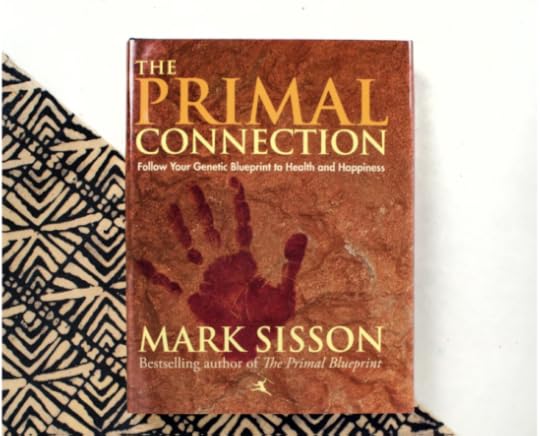 Of all the books I’ve written, this one sold the least. And yet it’s my favorite one of all time, and it’s the one that generates the most heart-felt responses from readers. Those who did buy it and read it were almost all affected. It helped them re-evaluate the way they’re living (not just eating and exercising). The way they practice self-care and gratitude. The way they form and maintain relationships, professional and romantic alike. Most importantly, it has helped thousands have a better relationship with themselves—because that’s the relationship modernity has fractured more than anything else.
Of all the books I’ve written, this one sold the least. And yet it’s my favorite one of all time, and it’s the one that generates the most heart-felt responses from readers. Those who did buy it and read it were almost all affected. It helped them re-evaluate the way they’re living (not just eating and exercising). The way they practice self-care and gratitude. The way they form and maintain relationships, professional and romantic alike. Most importantly, it has helped thousands have a better relationship with themselves—because that’s the relationship modernity has fractured more than anything else.
Gifts for Kids
Stock Tank
 Growing up my friend had a giant stock tank at his house that his dad used to wash the dogs and we used as a “pool.” Hey, when you’re six years old a stock tank feels like a swimming pool in the summer. This is one of the weirdest gifts, and no kid will probably ask Santa for one, but if you have the room for it the stock tank will quickly become a favorite. Don’t ask me why. It just works. Get as big as you can handle.
Growing up my friend had a giant stock tank at his house that his dad used to wash the dogs and we used as a “pool.” Hey, when you’re six years old a stock tank feels like a swimming pool in the summer. This is one of the weirdest gifts, and no kid will probably ask Santa for one, but if you have the room for it the stock tank will quickly become a favorite. Don’t ask me why. It just works. Get as big as you can handle.
Amber Reading Lights
 I have fond memories of sneaking books and a flashlight under the covers after lights out, reading adventure stories late into the night. But man, I look back and shudder at what that was doing to my circadian rhythm. Luckily, there are better options for kids who want to trade sleep for trips to the world of literature: Amber clip-on reading lights. These clip on to the book and emit a warm, amber-colored candle-like glow that is easy on your circadian rhythm and has minimal impacts to melatonin production. Kids need to read but they also need to sleep. This let’s them do both.
I have fond memories of sneaking books and a flashlight under the covers after lights out, reading adventure stories late into the night. But man, I look back and shudder at what that was doing to my circadian rhythm. Luckily, there are better options for kids who want to trade sleep for trips to the world of literature: Amber clip-on reading lights. These clip on to the book and emit a warm, amber-colored candle-like glow that is easy on your circadian rhythm and has minimal impacts to melatonin production. Kids need to read but they also need to sleep. This let’s them do both.
Paleo Girl book
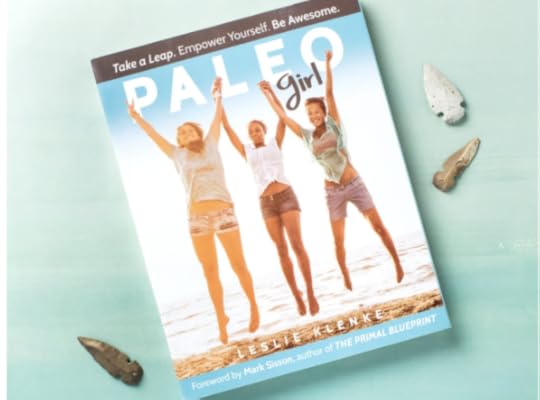 I’ve raised a boy and a girl up from childhood through adolescence and on into adulthood. I have to say, the teen years for my daughter Devyn was probably the toughest bit of parenting I’ve ever had. It wasn’t bad, it turned out great, but it wasn’t easy. There’s a lot going on during those years. I wish I’d had this book, Leslie Klenke’s Paleo Girl, on hand to at the very least hand it over to her to read. I consider it an invaluable resource.
I’ve raised a boy and a girl up from childhood through adolescence and on into adulthood. I have to say, the teen years for my daughter Devyn was probably the toughest bit of parenting I’ve ever had. It wasn’t bad, it turned out great, but it wasn’t easy. There’s a lot going on during those years. I wish I’d had this book, Leslie Klenke’s Paleo Girl, on hand to at the very least hand it over to her to read. I consider it an invaluable resource.
Oh, and they’re great for adults, too.
What about you, folks? What Primal gifts are you currently coveting? What are you giving out this year? Let us know in the comment section!

The post Primal Gift Guide 2020 appeared first on Mark's Daily Apple.



November 24, 2020
Holiday Meal Script: When and How to Explain Your Food Choices
 Holiday get-togethers can be dicey, even uncomfortable, for those of us who eat a “weird” diet. Everyone has an opinion or a biting remark. As tempting as might be, you can’t just holler, “I’m not weird, YOU’RE weird. I’M eating a SPECIES-APPROPRIATE DIET!” in Aunt Martha’s face when she tries once again to put a biscuit on your plate.
Holiday get-togethers can be dicey, even uncomfortable, for those of us who eat a “weird” diet. Everyone has an opinion or a biting remark. As tempting as might be, you can’t just holler, “I’m not weird, YOU’RE weird. I’M eating a SPECIES-APPROPRIATE DIET!” in Aunt Martha’s face when she tries once again to put a biscuit on your plate.
You have to say something though, right? Or do you? When do you have to explain your food choices?
I’m tempted to say: Never. End of post.
By and large, your diet is nobody else’s business. But communication is vital in relationships, and here’s where it gets tricky. On the one hand, you don’t owe anyone an explanation, and it’s disrespectful on their part if they expect you to justify or defend your choices. Often, though, people are just concerned, confused, or simply curious. You don’t owe these folks an explanation, but in the spirit of open communication, you might choose to offer them one.
General tips for keeping the peace:
Keep it personal. You won’t get as much pushback if you focus on how your diet makes you feel. Don’t launch into a lecture about phytates or how soda is ruining our country’s health. Nobody’s looking for a lesson on leaky gut and inflammation during dinner.
Don’t overexplain yourself or get defensive. Keep it short and sweet, then move on.
Don’t try to convert them. If you start to proselytize, you’re doing the same thing to them that they’re doing to you. Your simple explanations will plant the seeds for anyone who’s interested in learning more later.
Don’t get sucked into an argument. State firmly that you’d rather not discuss your diet. If the other person continues to challenge you, walk away (or, in 2020, leave the Zoom).
Beyond that, the best strategy for dealing with diet queries depends on who’s asking and why:
Mild Incomprehension
This is the “I don’t get it…” and “Wait, so you’re not going eat stuffing?” crowd. There’s no malice. They just can’t grasp why someone would give up bread and pasta.
Strategy: Deflect
“Haha, I know, I thought it was crazy when I started, too, but I can’t believe how much better I feel. Plus I get to eat all the turkey. Ooh, will you pass me a leg? Hey, how’s work going?”
“No stuffing for me, thanks. I’m trying this experiment for a while longer. Did I see on Facebook that you’re writing a book?”
“It’s true, I’m eating Primal/paleo/keto/carnivore now, but you don’t want to hear me ramble on about my diet. Let’s go see if Mom needs help setting the table.”
Sincere Curiosity
You can tell these folks from their tone of voice. They are genuinely interested in hearing what you’re doing (and maybe even trying it for themselves).
Strategy: Lightly educate
It’s up to you how deep you want to go here. My advice is to stick to basics and offer to talk more later. Avoid launching into a diatribe about why they should cut out grains and sugar while they have a bite of pie halfway to their lips.
“I kept hearing people say how much better they felt after cutting out gluten and dairy, so I decided to try it for myself. They were right. It helped so much with some health issues I was having. It was hard at first, but every time I eat bread now, I remember how much worse I used to feel. I’m much happier eating this way.”
“Really, it just means that I’m eating tons of plants, meat, eggs, and stuff like nuts and cheese, and dark chocolate. Easy. The big thing I’ve noticed is how much more energy I have. My skin cleared up, too. If you’re ever interested in trying, I can tell you more.”
“Some of my friends wanted to try keto, so we all read this book called The Keto Reset Diet for our book club. It’s been five months, and I’m still going strong. The book made it easy if you ever want to borrow it.”
Mockery
Good-natured teasing is one thing, but ridicule is another. Keep your cool and get out of these conversations as quickly as possible. There is nothing to be gained from engaging. Depending on your relationship with the person, you might use humor or directness, but either way, shut it down.
Strategy: Escape
“Good one, Uncle Greg. Hey, I’m going to get some egg nog.”
“Isn’t it great how we don’t all have to eat the same diet, yet we can still be friends! I’m going to go check the score of the football game.”
“I’d rather not get into an argument about this, so let’s change the subject.”
Criticism
This one’s a little more complicated because criticism can come from very different places. Some people are just mean-spirited grinches who like to find fault in others. With them, use the escape strategy above. Don’t let them bring you down to their level.
Often, though, when people criticize your diet, it comes from a place of fear or insecurity, not hostility. Fear because what you’re doing goes against everything they believe to be true about health. All they may know about your keto diet, for example, is that a fitness celebrity told them it is dangerous. Or, they may feel threatened by the uncomfortable realization that they could be doing more to be healthy themselves.
Put yourself in their shoes and try to understand where they’re coming from. You’re not going to unpack all the layers of flawed conventional wisdom, self-esteem issues, and complicated family dynamics in this one conversation, but at least you can respond with compassion and grace.
Strategy: Acknowledge, reassure (for fear-based criticism), change the subject
“Thank you so much for caring about my health. My doctor knows how I eat, and my labs are great. Let’s go see what the kids are up to.”
“People do say this is a fad, but honestly, it’s how everyone used to eat in previous generations. It’s nothing new, and I’ve never felt better than I do eating this way. But anyway, I heard you guys are adopting a puppy!”
“Yes, I know they say that whole grains are important for health. I’m always open to changing my diet again, but I’m going to try this way of eating for a little while. Do you think anyone would like to go for a walk before dinner?”
“Yes, that ‘documentary’ caused quite a stir, didn’t it. To be honest, there were a lot of problems with the science. I don’t want to bore you with all the details, but I can send you a blog post. It outlines all the flaws and provides a bunch of journal citations if you’re interested. Just email me to remind me. Do these green beans have bacon in them? So good!”
The Guilt Trip
These people act as if your diet is a personal affront to them. “You’re not going to have any of the pie I worked so hard on?” “What’s Christmas without cookies?” “But you always loved my cornbread stuffing!”
You don’t need them to understand or approve. They just need to respect your choices or at least be quiet about them.
Strategy: Flip it back on them
“Oh Aunt Mildred, I do love your pie! At times like these, I wish I hadn’t discovered how sick gluten makes me. I know you’d hate for me to spend the rest of the evening in the bathroom!”
“Cookies are great, but the only thing I really want is to spend time with you. Family is so important to me, and we don’t see each other enough.“
“You’re right, but I’ve learned that I feel so much better when I eat this way. It’s hard to say no, but I’m sure you’ll support me like you always have. Thank you so much for understanding!”
The Exceptions to the Rule
I said you never have to explain your food choices, but it’s just common courtesy to let your hosts know ahead of time. Explain your situation, and make it clear that you are not expecting them to change their menu to accommodate you. Offer to bring a side dish or dessert.
If you are hosting, and you plan to make only options that suit your diet, you aren’t required to give your guests notice. However, if that means you’re not making traditional dishes that your guests will expect, you might give them a heads up. Let them have the option of bringing their own Hawaiian rolls.
Lastly, remember that while you don’t owe it to anyone, it might be ok to chill on some of your diet rules for one night. A few bites of pie could be a small concession to keep the peace (as long as it won’t make you sick). Of course, if your family or friends are going to make it that unpleasant, you’re also free to decline the invitation.
Have you had to deal with less-than-supportive friends or family since you changed your diet? How did you handle it?
The post Holiday Meal Script: When and How to Explain Your Food Choices appeared first on Mark's Daily Apple.



Mark Sisson's Blog
- Mark Sisson's profile
- 199 followers










